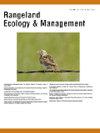确定针叶林管理的空间优先次序,以保护和发展灌木丛核心区
IF 2.4
3区 环境科学与生态学
Q2 ECOLOGY
引用次数: 0
摘要
由于针叶林地和森林的扩张等众多威胁,美国西部的沙棘生态系统正在衰退。最近,跨机构的 "鼠尾草保护设计 "工作对鼠尾草生态完整性(SEI)进行了量化,以绘制剩余的核心鼠尾草区域(相对完整且功能正常的鼠尾草生态系统),并了解与主要威胁相关的时空变化模式。最近的研究发现,针叶林的扩张是导致整个生物群落的灌木丛生态完整性下降的第二大原因。在此,我们试图确定针叶林管理的空间优先次序,使保护和发展核心鼠尾草区域的投资回报最大化。我们使用多标准决策分析(MCDA)将一系列生物群落层面的输入信息(包括 SEI、入侵一年生草覆盖率和风险、结构连通性、针叶林覆盖率和扩展脆弱性)纳入基于专家合作输入的单一优先级排序中。我们的分析确定了整个鼠尾草生物群落中针叶林管理的优先区域,根据这些优先区域模拟了针叶林的处理方法,并估算了有针对性的处理方法可能导致的 SEI 变化。从广义上讲,我们发现针叶林管理的最高优先级区域主要位于落基山脉以东。这与近期鼠尾草系统针叶林管理的景观趋势不同,后者主要集中在大盆地松柏-桧柏的扩张上。大部分(52%)最优先区域由土地管理局管理,其次是很大一部分(26%)位于私有土地上的优先区域,尤其是在怀俄明州和蒙大拿州。使用我们的优先级进行针叶树的模拟目标处理,其核心内目标处理百分比(≥93%)高于正常情况下的目标处理百分比(23.8%),这将使核心内优先区域的处理时间缩短四到八倍。最后,我们证明,根据我们的优先排序,这些模拟处理有能力改善处理区域及其周围的 SEI。这项工作为 "捍卫核心 "提供了一条可行的途径,正如 "鼠尾草保护设计 "所概述的那样,它可以帮助保护工作者更有效地解决鼠尾草核心区及其周围针叶林扩张的问题。本文章由计算机程序翻译,如有差异,请以英文原文为准。
A Spatial Prioritization of Conifer Management to Defend and Grow Sagebrush Cores
Sagebrush ecosystems across the western U.S. are in decline due to numerous threats, including expansion of coniferous woodlands and forests. The interagency Sagebrush Conservation Design effort recently quantified sagebrush ecological integrity (SEI) to map remaining core sagebrush areas (relatively intact and functional sagebrush ecosystems) and understand spatial and temporal patterns of change relative to primary threats. Recent work has identified conifer expansion as the second leading cause of decline in sagebrush ecological integrity biome wide. Here, we sought to create a spatial prioritization of conifer management that maximizes return-on-investment to defend and grow core sagebrush areas. Multi-criteria decision analysis (MCDA) was used to incorporate a series of biome-level inputs including SEI, invasive annual grass cover and risk, structural connectivity, and conifer cover and expansion vulnerability into a single prioritization based on collaborative expert input. Our analysis identifies priority areas for conifer management across the sagebrush biome, simulates conifer treatments based on those priorities, and estimates potential changes in SEI as a result of targeted treatment. At a broad scale, we found that the highest priority areas for conifer management were largely located east of the Rocky Mountains. This represents a departure from recent landscape-level trends of conifer management efforts in sagebrush systems, which were focused primarily on pinyon-juniper expansion in the Great Basin. A majority (52%) of the highest priority areas are managed by the Bureau of Land Management, followed by a large proportion (26%) of priority areas located on privately-owned land – particularly in Wyoming and Montana. Targeting simulated conifer treatments using our prioritization resulted in higher within-core targeting percentages (≥93%) than business-as-usual efforts (23.8%), which would result in a four- to eight-fold reduction in the time to treat priority areas within cores. Finally, we demonstrate that these simulated treatments, targeted with our prioritization, have the capacity to improve SEI in and around treatment areas. This work provides an actionable path to “Defend the Core” as outlined by the Sagebrush Conservation Design effort by helping conservationists more efficiently address conifer expansion in and around core sagebrush areas.
求助全文
通过发布文献求助,成功后即可免费获取论文全文。
去求助
来源期刊

Rangeland Ecology & Management
农林科学-环境科学
CiteScore
4.60
自引率
13.00%
发文量
87
审稿时长
12-24 weeks
期刊介绍:
Rangeland Ecology & Management publishes all topics-including ecology, management, socioeconomic and policy-pertaining to global rangelands. The journal''s mission is to inform academics, ecosystem managers and policy makers of science-based information to promote sound rangeland stewardship. Author submissions are published in five manuscript categories: original research papers, high-profile forum topics, concept syntheses, as well as research and technical notes.
Rangelands represent approximately 50% of the Earth''s land area and provision multiple ecosystem services for large human populations. This expansive and diverse land area functions as coupled human-ecological systems. Knowledge of both social and biophysical system components and their interactions represent the foundation for informed rangeland stewardship. Rangeland Ecology & Management uniquely integrates information from multiple system components to address current and pending challenges confronting global rangelands.
 求助内容:
求助内容: 应助结果提醒方式:
应助结果提醒方式:


